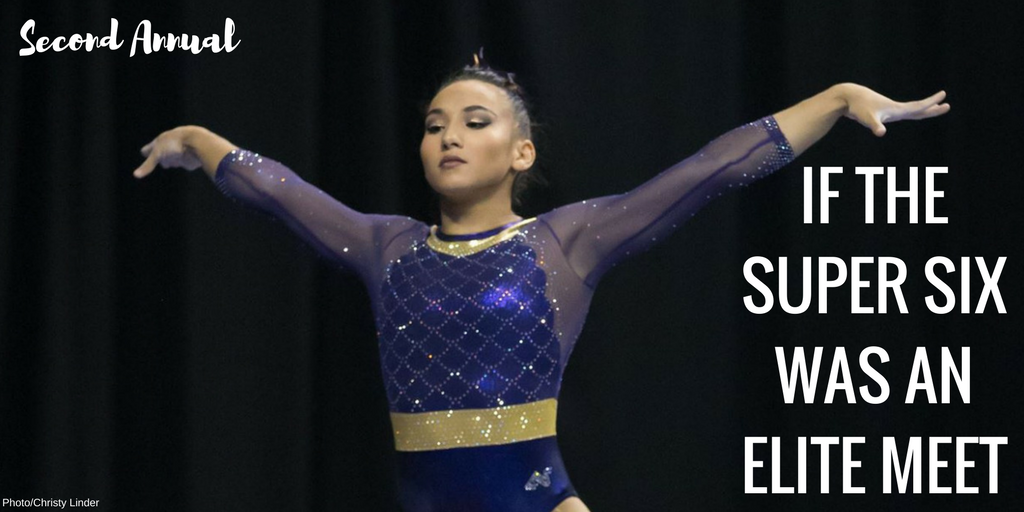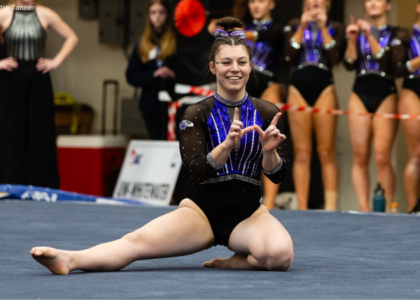By Caroline Medley

Last year, we looked at how the Super Six would look if it were scored under the elite code, and discovered that the results would have differed pretty significantly when we threw difficulty into the mix. The results were so surprising, in fact, that we’ve decided to do it again this year!
Again, we predict that difficulty will win out, but without looking at breakdowns of routines, with so much elite talent in the NCAA, it’s hard to say which team has the most overall difficulty! If you’d like to follow along rotation by rotation, here is the full competition stream courtesy of your gymternet savior and ours, NastiaFan101!
Rotation 1
VT: UCLA – 72.400
UB: Bama – 65.188
BB: UF – 69.075
FX: Utah – 68.7625
So let’s start by talking about scoring differences here. Since vaults are simply assigned D-scores, while the other three events require gymnasts to build their difficulty, vault was consistently the highest-scoring event for every team by far. Because vault’s high D-scores benefit all teams, though, UCLA won’t see any benefit from this phenomenon in the long run, as theirs is actually the lowest vault total of the competition. This is of course related to their lack of 10.0 start value vaults, which in the elite code translates to lower D-scores. The difference between competing a Yurchenko full and a Yurchenko 1.5 is a whopping four tenths, so while UCLA starts out ahead simply because they’re on vault, that edge will be negated once teams like OU and LSU go to vault, since they have more difficult vaults in their lineup.
Bars, on the other hand, was consistently the lowest-scoring event for each team. This is a product of the number of compositional requirements (CR) the gymnasts typically fulfill, because each CR is worth 0.5, a significant chunk of change when you consider that under this scoring method, this competition is won by less than two points. Bars is where the NCAA code is the most lenient on a routine’s requirements, while the elite code has very strict specifications for what must be included. Like last year, the most commonly missed CR was the requirement that a gymnast have a 360-degree turn in a non-flight element, i.e. a pirouette of some kind. Also commonly missed was the requirement of a grip change, where the hands change direction/position on the bar. In addition, thanks to the loophole created by NCAA rules, some gymnasts don’t even compete a single-bar release. Missing all of these would total to 1.5 lost in their D-score. That’s a big loss to take when every tenth makes a difference. Most teams did not put up impressive bar scores as most gymnasts did not meet all CR, but Alabama’s was the lowest of the bunch, thanks to the execution issues its gymnasts had in addition to their low difficulty. Shea Mahoney was one of only six gymnasts who missed all three of the previously mentioned CR, leaving her CR at just 0.5/2.0 and her total D-score at a 2.5. None of Alabama’s gymnasts reached the full 2.0 CR on bars, either.
Beam’s major problem CR from last season was the required D dismount, but since the new code has removed that, gymnasts typically met all CR, which was a welcome change. All but one of Florida’s beam lineup met the full 2.0 CR, which helped them to D-scores 4.0 or higher, making it their most difficult rotation of the meet (except vault, but that’s a given for everyone). That also places their beam squad second as far as number of D-scores over 4.0. Marks like that are still about a full point lower than what it would take to score well internationally, but considering the average D-score for the meet was under a 4.0, having almost a full rotation exceed that is a feat in itself. The only Florida beamer not to meet all CR, and thus ending with a 3.2 D, was Grace McLaughlin. Elite code does require that the dance series include a 180-degree split element, and while she does a split jump, it was not connected to the rest of her dance series. So despite the fact that McLaughlin stayed on the beam and Rachel Gowey did not, Gowey’s score ended up being counted toward the team total instead because her D-score is so much higher.
The requirements for floor routines are so drastically different between NCAA and elite that many gymnasts do not meet the full CR. Utah is actually the exception to this rule, with only two of their gymnasts missing any CR, and that actually led them to the highest floor total of the competition. Both Macey Roberts and Tiffani Lewis miss the traveling dance passage CR, which requires gymnasts do leaps and/or hops connected by chassés or runs. Jumps don’t count, because they don’t travel, and both Roberts and Lewis have dance combinations with at least one jump. Unsurprisingly, Mykayla Skinner had the highest score of the rotation with a 4.6 D-score, the highest of any floor routine in the competition. She also does the hardest single element in the entire combination. Her double double, also known as a Silivas, is an H element in the elite code, a full two tenths higher than a double layout, the previous skill that held the title of most difficult in the competition, which is valued at an F.
Rotation 2
VT: Utah – 73.2625
UB: OU – 68.0750
BB: Bama – 68.225
FX: LSU – 68.3250
Vault again pulls ahead of the pack here, putting Utah at a good advantage early on here. Skinner’s DTY ties those of McMurtry and Gnat later on for the highest D-score in the competition at 5.4. The DTY is pretty much standard for top all arounders in US elite competition and is more difficult than many vaults competed by even top international elite gymnasts. However, Utah still only has two vaults harder than the FTY, so they can only capitalize but so much on vault’s extra scoring bump.
Oklahoma started their competition off with a bang, receiving the highest bars total of the competition after sitting on a bye for the first rotation. Chayse Capps and McKenzie Wofford are two of only six gymnasts in the entire competition to meet the full CR on bars. Her 4.2 total D-score ties Wofford for the highest bars difficulty with Myia Hambrick, who will go later on. In addition, half of their gymnasts (Catour, Dowell, and Nichols) have E elements in their routines, whether releases or transitions, giving them each an extra tenth over the average NCAA routine. Nichols actually has two, giving her even more of an edge.
On beam, Alabama’s troubles continued in execution, but their D-scores skyrocketed. All six gymnasts in the lineup met all CR, and three got at least an extra tenth in series bonus (SB) or connection value (CV). Series bonus has changed in the new code, allowing for mixed series as well as acrobatic series. Series bonus is also now awarded for connecting elements to the dismount, so any dismount valued C or higher preceded by two back handsprings receives 0.1 SB. Many gymnasts in the NCAA balk at connecting so many acrobatic elements for fear of falling, but at Alabama, both Maddie Desch and Nickie Guerrero receive SB, and Desch does so for her dismount.
Last year, LSU killed it on floor, earning the second-highest floor total of the night, but this year they faltered just a bit. A score drop is to be expected with the change in code, as the CR was reduced by 0.5, so all scores would drop by 0.5 when fulfilling all CR. However, it seems that compared to last year, some of the gymnasts’ dance elements were downgraded or simply removed that ended up dropping some extra tenths off their D-scores. Each routine must count at least three dance elements, and many floor routines, not just from LSU, only have two dance elements. This forces the gymnasts to only count seven elements instead of eight, which doesn’t incur a penalty for a short exercise, but drops the D-score at least a tenth, sometimes more, simply because they can’t count another element. Gnat still racked up a 4.2 D-score and met all CR, which is commendable, but even that puts her squarely behind Skinner, Nichols, Baker, Winston and even Ohashi on the floor difficulty leader board. This wasn’t exactly the boost we’d expected LSU would get after an event where they boast three F skills and two Es.
Rotation 3
VT: LSU – 74.5625
UB: UCLA – 65.6375
BB: OU – 69.6625
FX: UF – 67.8000
Vault is really where LSU clawed back some ground under this scoring system. With only one vault with a D-score under a 5.0, the Tigers were in much better shape than any other team as far as vault went. LSU’s vault team averaged a score of 14.833, a number any elite, whether US or international, would be proud to earn.
Bars for UCLA was a bit more problematic. All the complaints across the gymternet this season about seeing two former individual world bars medalists doing such simple routines start to matter when we look at it under the elite code. And it is, in fact, Ross and Kocian’s routines that have the lowest D-scores, and would have scored the lowest overall if not for Meraz’s fall. Their D-scores were actually less than 3.0, some of the lowest in the entire competition. Stella Savvidou was the only Bruin on bars to meet all four CR, plus she competes a piked Jaeger, which was upgraded to an E skill in the new code. That gave her a 3.9, which was the highest D-score of the UCLA bar lineup. Compared to OU before them, these numbers are far less than ideal.
The Sooners on beam are always a sight to see, but their difficulty landed them in the middle of the pack on this event. Though all their gymnasts met the full CR and some even got CV or SB, their lack of risk-taking limited their ability to score big. However, despite the fact that there were no E elements in the whole rotation, Capps became the first gymnast of the competition so far to count all eight elements valued at a B or higher. In an NCAA routine that’s so short and so focused on basics, that in itself is a feat.
On floor, the Gators played it safe some as well, as they had one fewer E pass than last year: neither McLaughlin, Slocum or Hundley competes one. McLaughlin’s floor actually has the team’s lowest D-score of the night, at a 2.7, missing out on a full point of CR because she doesn’t have a double salto or the correct kind of dance passage. The Gators also took some risks as well, though, as McMurtry and Boren both threw their sky-high E passes, a triple twist and a tucked full-in respectively. But it was Kennedy Baker here who really stole the show as far as difficulty goes. Not only is she the only Florida floor worker to meet all four CR, she also had her double arabian so close to laid out this year that I gave her credit for it. In the code, there are specific guidelines as far as knee and hip angle to define tuck, pike, and layout positions. Baker may not have her body as straight as say, Gnat’s double layout, but if you see here in the broadcast, her hip angle is so open, even commentator Kathy Johnson Clarke thinks it’s basically laid out. Gymnasts are allowed about 10 degrees or so of leeway in her hip angle to still get credit for a laid out position rather than a piked position, and while I may not have a protractor, I’d credit her for it. In slow motion, it looks a little questionable, especially when she’s upside down, but the judges don’t have the benefit of slow-mo cameras or watching it back a hundred times, so I’ll give it to her. That boosts her to an H skill, tying her with Mykayla Skinner for the most difficult skill in the competition. Her 4.4 D-score also tied her with Nichols for the second-highest floor D-score of the night.
So after three rotations, each team has completed two events. Here’s how the scores stand right now.
Rotation 4
VT: UF – 73.8000
UB: UTAH – 67.0625
BB: UCLA – 70.5500
FX: BAMA – 68.4500
Florida’s vault rotation is sort of a mixed bag when it comes to difficulty. Boren and Baker’s Yurchenko 1.5s and McMurtry’s DTY give them a much-needed boost, over a point of total extra difficulty over the normal FTY. But while Slocum’s handspring pike half is a 10.0 SV vault in NCAA, it’s worth no more than the FTY in the elite code. However, as far as execution is concerned, Slocum’s vault was likely worth more than any FTY that wasn’t already in the lineup. The only vault that you could potentially make a case for including over Slocum’s would be Chant’s Tsuk full, which is worth a 4.8, two tenths more than Slocum’s handspring pike half. However, historically, Slocum’s execution has been better than Chant’s, so even when considering elite difficulty, Slocum is still probably the better choice.
Bars for the Utes was also a mix of good and bad as far as difficulty goes. While she does receive CV for connecting her two D transitions, Skinner is another former top elite whose bars come nowhere close to meeting the full CR. Her 2.5 D-score is the team’s lowest of the night, and teammate MaKenna Merrell wasn’t much better at 2.9. However, Lewis and Rowe both met the full four CR and some decent difficulty, with 4.1 and 4.0 D-scores, respectively, so things balanced out in the end.
UCLA finally gets the boost they needed with their huge difficulty on beam. They have the second-highest beam difficulty average, as every single one of these routines met the full CR, and four of their six routines counted no A elements, a feat no team replicated this year or last. Mikaela Gerber actually has no A elements in her entire routine, now that the split jump has been upgraded to a B skill. Kocian, Ross and Lee then hit a 1-2-3 punch of difficulty, counting no A elements and scoring a 4.3, 4.5 and 4.5 in difficulty, respectively. If Ohashi had thrown her full difficulty, they likely would’ve had the highest beam difficulty average of the night, and we would have had our first element higher than an E on beam. Lee’s beam difficulty actually would’ve been higher if she had done her normal Homma flares to mount the beam, which consists of three consecutive flares. It was a blink-and-you’ll-miss-it moment, but check it out here: Peng actually performs the element named after herself in the code, the Lee, meaning just two flares rather than three. Though the Lee is only a B and the Homma D, I don’t think anyone can blame her for wanting to do her own skill in what she thought might be her last meet ever!
Floor was a good reset moment for Alabama, as their strongest non-vault rotation of the competition in overall scores, though beam was stronger in pure difficulty. Only Bailey and Winston met the full CR on floor, but five of their six gymnasts had either E or F passes to lead off their routines. Many of the gymnasts could have even had higher D-scores had they just had one more dance element, as they were forced to count only seven skills due to the three-dance-element requirement. Winston also notched the team’s highest non-vault D-score, a 4.3, here on floor.
Rotation 5
VT: BAMA – 72.8875
UB: LSU – 66.8750
BB: UTAH – 68.9500
FX: OU – 67.6875
Alabama is really where we can talk about where vaults are valued differently in the NCAA versus elite. Katie Bailey’s Yurchenko layout half now starts at a 9.95, not a 10.0 like last year, but it’s still worth just as much as the FTY in the NCAA code. If the competition had been scored under elite code, Bailey would never have made the lineup. The Yhalf is worth four tenths less than the FTY at a low 4.2. Anyone else on the team with a full, as long as they put it to their feet, would likely have beaten Bailey’s total score under the elite system.
As expected, LSU’s weakest event was bars, though there were a few bright spots. Considering Myia Hambrick was never an elite, she satisfies the elite code requirements very well, as she’s the only Tiger who met all CR on bars. She also later fulfills them all on beam as well, and only missed one CR on floor. Her total D-score on bars was a 4.2, which ties Wofford of OU for the highest bars D-score of the competition. Ruby Harrold also notched an impressive 4.0, even while missing the 360 non-flight element portion of her CR.
Utah’s beam difficulty ranged from just meh to pretty impressive, as none of its gymnasts had any elements higher than a D value and all but one had to count at least one A skill. Skinner was the lone gymnast who counted all skills rated B or higher, and she also received CV for connecting her side aerial directly to a split jump. Her final D-score was a 4.5, tying Ross and Lee of UCLA for the second-highest beam D-score of the day. MaKenna Merrell had enough elements rated B and higher not to count any A skills, but because of the three dance element rule (it exists on beam too!) she has to count her full turn, an A, rather than her roundoff, a B. Nonetheless, her 4.2 D-score still ranks pretty high on the list.
Oklahoma did mostly pretty well on floor, with one big exception. Natalie Brown only got 0.5 CR, almost entirely due to her unvaried tumbling. Elite code requires a double salto, but she only does single flips with varying numbers of twists. The elite code will also no longer credit a random layout-stepout or aerial that isn’t in an actual pass as tumbling in that direction. Thus, she also does not get credit for tumbling both forward/sideward and backward, because per elite code, she only “tumbles” forward. Brown also does not receive credit for the correct dance passage. Her 2.4 D-score was the team’s lowest of the night. However, the rest of her teammates all scored 3.5 or higher in difficulty, despite the fact that none of them fulfilled all CR. Maggie Nichols came the closest, but she ran into the same problem as Brown where the code no longer credits tumbling for CR fulfillment unless it’s in an actual acro line. Nichols’s only forward element is her front tuck, which is not part of any acro line. If she’d done the front tuck through to her double twist, instead of the 1.5 through to the double, she would have satisfied that final CR and still gained another tenth, even after losing the value of the 1.5 twist and CV that went with it. Despite that, Nichols still has the highest D-score of the rotation for the Sooners, with a 3.9 D. Also notable here is that Chayse Capps performed her double layout, actually giving her the highest single skill value of the rotation at an F.
Rotation 6
VT: OU – 74.0750
UB: UF – 65.3375
BB: LSU – 71.3250
FX: UCLA – 68.5750
To no surprise, Oklahoma’s vault score was the second-highest of the meet, only to LSU, who has one more 10.0 SV vault under the NCAA code than Oklahoma does. This is the clearest demonstration of just how much difficulty matters under the elite code. What will be interesting to see in the coming years, as we make this an annual exercise, is how LSU vault fares without its DTY or one of its reliable 1.5s. Oklahoma will retain all of its in the coming season, but LSU will not.
Though Florida did pretty well on bars, including another 10.0 for McMurtry, their difficulty was the lowest of the bunch, making what should have been one of their strongest events into a weaker one. Most of them only fulfilled two of the four CR, and Hundley only completed one for a mere 0.5 CR. She falls into the same group as Kocian, Ross and Skinner of former elites who’ve elected not to do a single-bar release anymore, which hurts them all under the elite code. Baker was the only one of the group to fulfill three CR, which earned her the highest D-score of the Gators’ bars rotation at 3.6.
Beam was where LSU’s difficulty finally had time to shine. Three of the six gymnasts here had E skills on beam, which is more E skills than the rest of the beam teams had combined. In addition, three of the six counted no skills below a B value. Finnegan was the only overlap between those two groups, so that really demonstrates the true distribution and depth of difficulty throughout the team.
Floor typically isn’t UCLA’s strong suit, but they actually didn’t do too poorly here. Ohashi and Cipra had the highest points, with both of them meeting all CR, and Ohashi was the only floor performer in the entire competition that did not have to count any A elements. Mossett’s was the weakest of the bunch at 2.5, as she fell prey to a lack of forward/sideward tumbling in an acro line. Her piked side somi is lovely, but it unfortunately doesn’t count toward her CR. UCLA is also the only team in the entire competition without any tumbling rated E or higher. You would think that would put it at the bottom of the barrel, but UCLA actually has the second-highest floor total of the competition!
We’ve finally reached the end! Think you know who won? Let’s check out our infographic!
In total, we had six of 36 gymnasts fulfill all bars CR, only one gymnast miss any CR on beam, and 11 of 36 fulfilled all floor CR. If you’d like to see how D and E scores relate, check out this cool four-page infographic. Those that maximized both execution and difficulty will be in the top right-hand corner of the graph, while some might be closer to the left side or to the bottom if they were only able to capitalize on one scoring dimension. Our charts are all interactive, so you can hover over the dots to discover who scored what. Some scores may seem to be omitted here either because two dots overlap each other, or because they were outliers that caused the graph not to show the true distribution of the entire data set.



